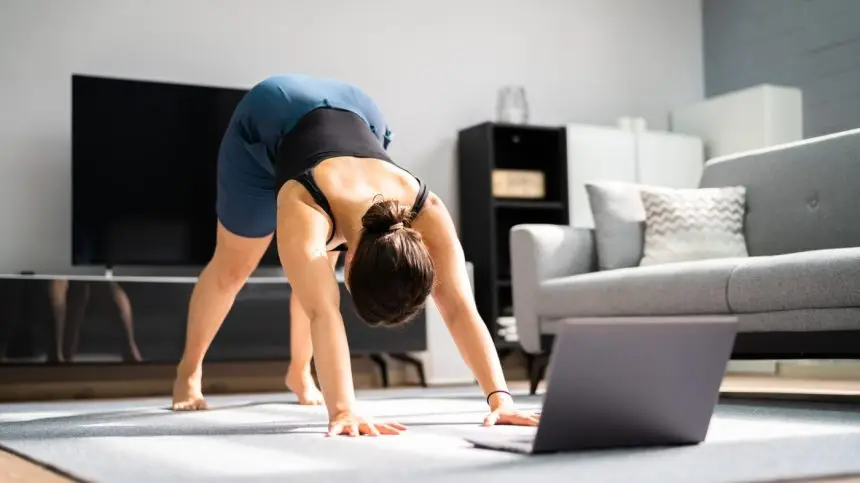On-line yoga lessons relieved continual low again ache and slashed the necessity for pain-relief drugs, a brand new research exhibits.
Again ache victims who took 12 weeks of digital live-streamed yoga lessons additionally slept higher and moved extra simply than members on a wait checklist for the lessons, the research printed in early November in JAMA Community Open reported.
“Their ache ranges actually have been reduce in half,” mentioned Dr. Robert Saper, the research’s senior creator and chair of the division of Wellness and Preventive Medication on the Cleveland Clinic.
“I discover this very thrilling as a result of we now have this big chunk of sufferers, 95% of sufferers, the place we generally do not know what to do,” mentioned Dr. Roger Hartl, neurosurgical director of Och Backbone at New York-Presbyterian/Weill Cornell Medical Heart, who was not concerned with the research.
Digital yoga can be one thing to supply such sufferers, he added. “Why not, if it really works, it is secure and efficient?”
People spend an estimated $135 billion a 12 months in well being care associated to decrease again ache, and an estimated 80% of adults undergo from it, earlier research have proven.
The brand new research targeted on well being care workers, group with a number of again ache.
The research authors be aware sufferers usually discover it difficult to attend in-person yoga lessons. “In consequence, drugs and different higher-risk interventions are sometimes prescribed, regardless of their restricted effectiveness and danger of opposed results,” the research says.
After the COVID-19 pandemic pressured many yoga academics to supply lessons on-line, Saper and his colleagues determined to check the effectiveness of digital yoga in what they consider is the primary research of its variety.
Researchers divided 140 Cleveland Clinic worker well being plan sufferers in Ohio and Florida with continual low again ache into two teams: one obtained digital hatha yoga lessons, and the opposite was on a wait checklist for yoga.
In the beginning of the research, members, principally college-educated white girls between the ages of 38 and 59, reported their again ache ranges as round 6 out of 10. After six weeks, the yoga college students’ reported ache ranges dropped to 4, and after six months, slid to three. The ache ranges of these on the ready checklist remained fixed.
In the beginning of the research, 74% of members have been taking some type of ache medication. Six months later, lower than one-third of the yoga practitioners have been taking ache remedy, whereas greater than half of the wait-list sufferers continued taking aspirin, ibuprofen, opioids and different ache relievers.
“I feel this expands the checklist of choices for sufferers,” Saper mentioned of the research outcomes.
Earlier this 12 months, Och Backbone’s Hartl and his colleagues printed the same research displaying {that a} 12-week digital program of tai chi, qigong and meditation relieved ache and improved sleep in adults with decrease again ache.
“Clearly, yoga is considerably completely different,” Hartl mentioned, “however definitely I feel this all goes in the best path, particularly, that these kind of just about guided interventions could be actually useful in sufferers.”
Quite a few earlier research have demonstrated the advantages of yoga or different back-related train to ease continual low again ache or enhance operate. The standard of the proof in lots of of those was not excessive although, be aware the authors of a 2021 Cochrane assessment. That is partially as a result of it is tough to blind members to the very fact they’re doing yoga.
Saper famous that yoga, “like many different self-care practices, will not be a fast repair.”
First, practitioners should discover ways to correctly and safely do the yoga postures. The lessons within the research have been tailor-made to starting yoga college students, and educated academics confirmed college students tips on how to use supportive props, like blocks and chairs, to adapt poses to their ability ranges.
College students within the research obtained video recordings and detailed workbooks to assist them apply safely on their very own.
The Nationwide Institutes of Well being considers yoga usually secure “for wholesome folks when carried out correctly, below the steering of a certified teacher” however cautions, “as with different types of bodily exercise, accidents can happen.”
Research have documented a variety of accidents linked with yoga, particularly amongst older folks.
Three of the brand new research’s members who took yoga lessons reported momentary flareups of again ache, presumably associated to the yoga.
Saper advises folks experiencing again ache to ask their medical doctors if therapeutic yoga is suitable for them. Individuals who undergo from continual ache ought to solely take yoga lessons geared to them, he mentioned.
Saper additionally tells yoga practitioners to “take heed to your physique as you progress and modify accordingly.”
Stretching could cause discomfort, he mentioned. However, he added, “In the event you really feel ache, it is best to come out of the pose or ask the trainer for variations.”
Ronnie Cohen is a San Francisco Bay Space journalist targeted on well being and social justice points.









